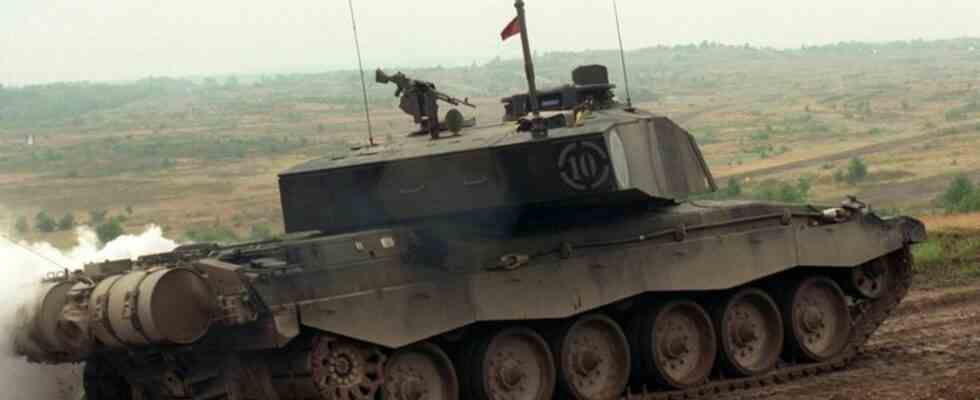war in Ukraine
London is also apparently considering supplying main battle tanks to Ukraine
The Challenger 2 main battle tank of the British Armed Forces (archive image). photo
© Holger Hollemann/dpa
After the promised delivery of armored personnel carriers to Ukraine, the pressure is growing to also give the country main battle tanks. There are similar considerations in Great Britain, and in Poland too. What is Berlin doing?
The debate about supplying Western main battle tanks to Ukraine is gaining momentum: Following corresponding demands from German members of the Bundestag, the Polish government is now also encouraging a broad coalition of several countries to hand over more modern tanks such as the German Leopard.
“Of course, theoretically we could also act individually, but here we need broader NATO cooperation because we also have to maintain our defense capability,” Deputy Foreign Minister Pawel Jablonski told Polish public radio. Jakub Kumoch, security advisor to President Andrzej Duda, told Radio Zet: “Things are in flux.” His country will not do anything alone.
According to a report by TV broadcaster Sky News, Great Britain is also considering a delivery of battle tanks. The broadcaster reported that up to ten Challenger 2 vehicles could go ashore to defend against Russian attacks. Corresponding discussions have been going on for weeks. Such a move would also encourage other states to supply main battle tanks, a “Ukrainian source” quoted Sky News as saying. The Challenger 2 can be compared to the German Leopard battle tank, the American Abrams or the French Leclerc.
Habeck: “We always check the situation”
After the American-German decision to supply infantry fighting vehicles, politicians from the Greens and the FDP as well as the opposition Union demanded that Ukraine also be given the Leopard battle tank. The Green Vice Chancellor and Federal Minister of Economics Robert Habeck made it clear on Sunday evening that a delivery of Leopard 1 or Leopard 2 tanks is not fundamentally ruled out. “We always check the situation, we coordinate with the other countries. And further decisions are also made within this corridor. That means: No, of course it’s not impossible,” said Habeck on the ARD program “Report from Berlin”. .
In battles between armored formations, battle tanks and armored personnel carriers work together with their crews and complement each other in terms of their capabilities. The federal government had agreed to provide Ukraine with 40 Marder infantry fighting vehicles. Main battle tanks are significantly more heavily armed and more powerful than armored personnel carriers.
A total of more than 3,600 Leopard 2 main battle tanks were built, including more than 2,000 in the now older Leopard 2A4 version. They are used in many countries. In addition to Poland, possible European partners in a joint delivery could also be Finland and Spain. The German armaments company Rheinmetall had also offered deliveries in the past. The Bundeswehr itself has a target stock of 320 Leopard 2A7V main battle tanks for the year 2025, but has even given up all older models such as the 2A4 version.
Scholz defends his course for arms deliveries in Ukraine
Chancellor Olaf Scholz has defended his course on arms deliveries. At an election campaign event of the Berlin SPD, he countered allegations that he was too hesitant about it. “Germany is way ahead in supporting Ukraine,” said Scholz. This applies not only to financial and humanitarian aid, but also to arms deliveries.
The SPD politician emphasized that he would continue to act responsibly. “Everyone can rest assured that we will do what is right and good for Ukraine and peace in Europe, not public excitement.”
The Chancellor emphasized that Germany, together with Great Britain, is now Ukraine’s most important arms supplier after the USA. “We will continue to do this,” he promised. And for as long as it is necessary. “As in the past, we will always be at the forefront when it comes to the scope and quality of the deliveries that we organize.”
However, Scholz also reiterated that this war must not become a war between Russia and NATO. And he also sticks to his principle that he will only act in coordination with his partners. “Germany will not go it alone, Germany will always stay together with friends and allies and especially with our transatlantic partner, the United States of America. Anything else would be irresponsible in such a dangerous situation.” The majority of citizens find this attitude correct.
SPD leadership supports Chancellor’s course “unreservedly”
At their closed meeting, the SPD leadership clearly supported Chancellor Olaf Scholz’s course on arms deliveries to Ukraine. “As the SPD leadership, we fully support the Chancellor’s course,” said party leader Lars Klingbeil. This also applies to the decision to deliver the Marder infantry fighting vehicle. Klingbeil did not comment on the question of the delivery of battle tanks. The SPD is considered the most skeptical of the three coalition parties when it comes to delivering weapons of a new quality to Ukraine.
It remained unclear exactly from which stocks Germany will supply the announced Marder infantry fighting vehicle. A delivery from the Bundeswehr was tested. However, Defense Minister Christine Lambrecht (SPD) had practically ruled out the transfer of Bundeswehr armored personnel carriers just before Christmas. She had been asked on Deutschlandfunk whether the decision, made because of breakdowns, to have the older Marder ready for a NATO mission instead of the Puma tank, meant that Ukraine could not hope for Marder. “We wouldn’t have handed over any martens from the Bundeswehr anyway. We need them,” she said. Hebestreit said the Federal Ministry of Defense “was already closely involved in the Chancellor’s decision-making process”.

